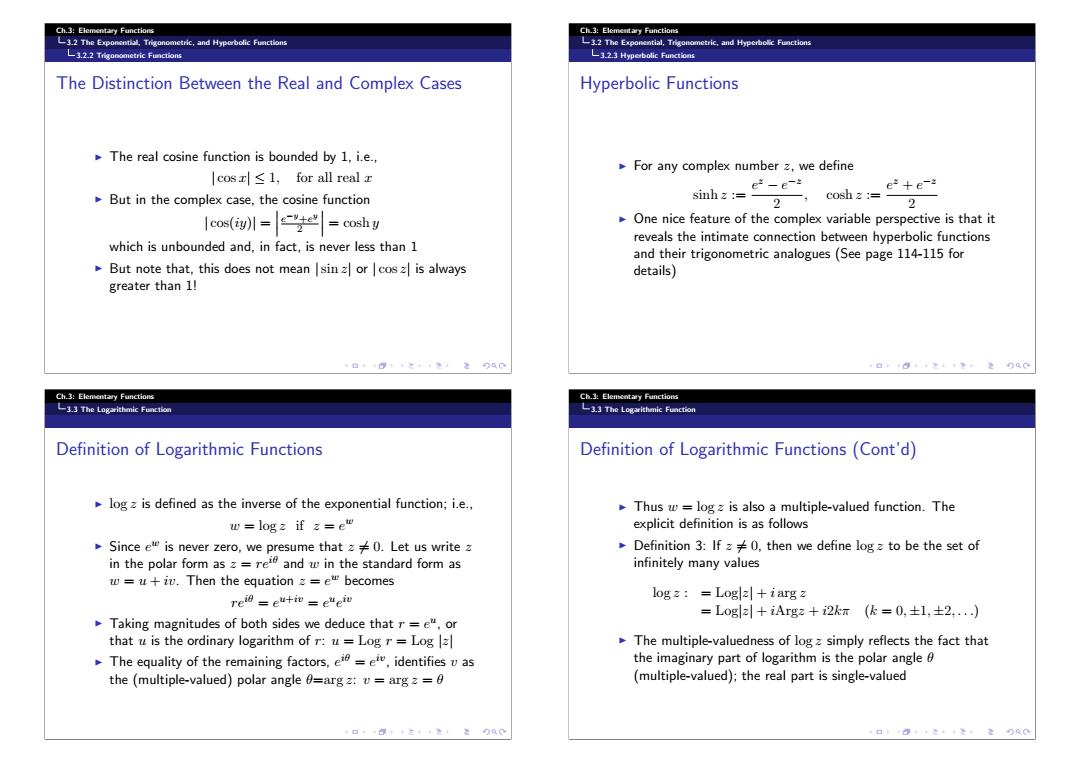正在加载图片...

Ch.3:Elementary Functions Ch.3:Elementary Functions L3.2 The Exponential,Trigonometric,and Hyporbolic Functions L3.2 The Exponential,Trigonometric,and Hyperbolic Functions L3.2.2 Trigonometric Functions L3.2.3 Hyperbolic Functions The Distinction Between the Real and Complex Cases Hyperbolic Functions The real cosine function is bounded by 1,i.e.. For any complex number z,we define cos<1,for all real r es-e-: e2+e-2 But in the complex case,the cosine function sinhz=2—,c0shz=2 1cos(训=拦| =coshy One nice feature of the complex variable perspective is that it reveals the intimate connection between hyperbolic functions which is unbounded and,in fact,is never less than 1 and their trigonometric analogues(See page 114-115 for But note that,this does not mean sin z or cos z is always details) greater than 1! +口·0+t。年之,220C Ch.3:Elementary Functions Ch.3:Elementary Functions 3.3 The Logarithmic Function 3.3 The Logarithmic Function Definition of Logarithmic Functions Definition of Logarithmic Functions(Cont'd) log z is defined as the inverse of the exponential function;i.e., Thus w=log z is also a multiple-valued function.The w=logz if z=et explicit definition is as follows Since et is never zero,we presume that z0.Let us write z Definition 3:If 20,then we define logz to be the set of in the polar form as z=rei and w in the standard form as infinitely many values w=u+iv.Then the equation z=et becomes re诏=eu+iw=e“ew logz:=Loglz+iargz =L0glz+iArgz+2km(k=0,土1,±2,.) Taking magnitudes of both sides we deduce that r =e",or that u is the ordinary logarithm of r:u Log r=Log z The multiple-valuedness of log z simply reflects the fact that The equality of the remaining factors,ei=ei,identifies v as the imaginary part of logarithm is the polar angle the (multiple-valued)polar angle 0=arg z:v=arg z =0 (multiple-valued);the real part is single-valuedCh.3: Elementary Functions 3.2 The Exponential, Trigonometric, and Hyperbolic Functions 3.2.2 Trigonometric Functions The Distinction Between the Real and Complex Cases The real cosine function is bounded by 1, i.e., | cos x| ≤ 1, for all real x But in the complex case, the cosine function | cos(iy)| = e−y+ey 2 = cosh y which is unbounded and, in fact, is never less than 1 But note that, this does not mean |sin z| or | cos z| is always greater than 1! Ch.3: Elementary Functions 3.2 The Exponential, Trigonometric, and Hyperbolic Functions 3.2.3 Hyperbolic Functions Hyperbolic Functions For any complex number z, we define sinh z := ez − e−z 2 , cosh z := ez + e−z 2 One nice feature of the complex variable perspective is that it reveals the intimate connection between hyperbolic functions and their trigonometric analogues (See page 114-115 for details) Ch.3: Elementary Functions 3.3 The Logarithmic Function Definition of Logarithmic Functions log z is defined as the inverse of the exponential function; i.e., w = log z if z = ew Since ew is never zero, we presume that z = 0. Let us write z in the polar form as z = reiθ and w in the standard form as w = u + iv. Then the equation z = ew becomes reiθ = eu+iv = eueiv Taking magnitudes of both sides we deduce that r = eu, or that u is the ordinary logarithm of r: u = Log r = Log |z| The equality of the remaining factors, eiθ = eiv, identifies v as the (multiple-valued) polar angle θ=arg z: v = arg z = θ Ch.3: Elementary Functions 3.3 The Logarithmic Function Definition of Logarithmic Functions (Cont’d) Thus w = log z is also a multiple-valued function. The explicit definition is as follows Definition 3: If z = 0, then we define log z to be the set of infinitely many values log z : = Log|z| + i arg z = Log|z| + iArgz + i2kπ (k = 0, ±1, ±2,...) The multiple-valuedness of log z simply reflects the fact that the imaginary part of logarithm is the polar angle θ (multiple-valued); the real part is single-valued��������������